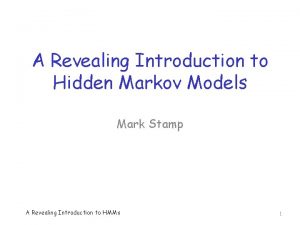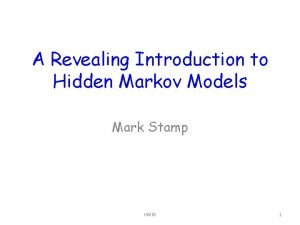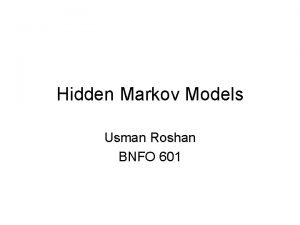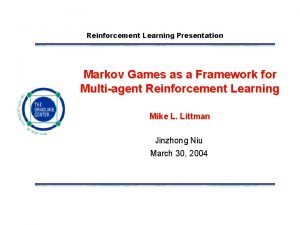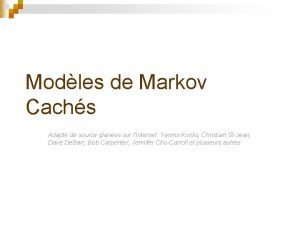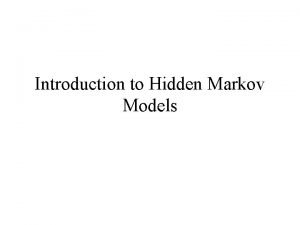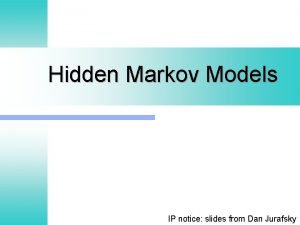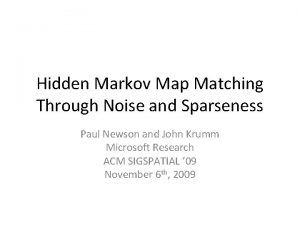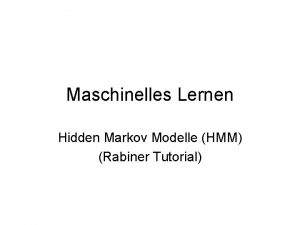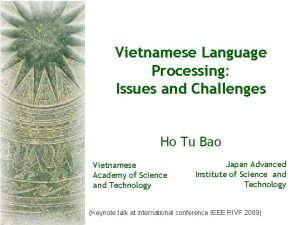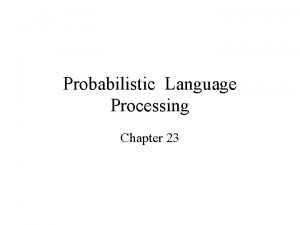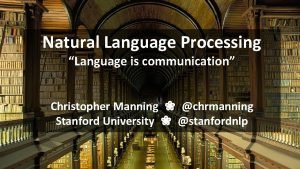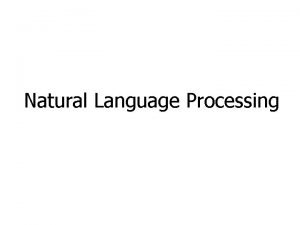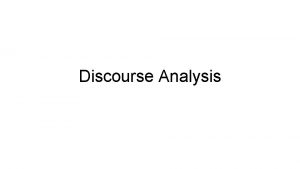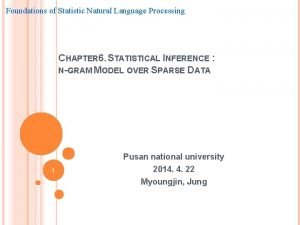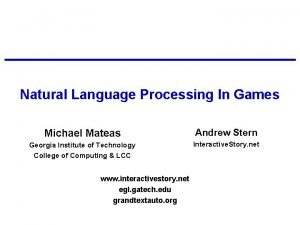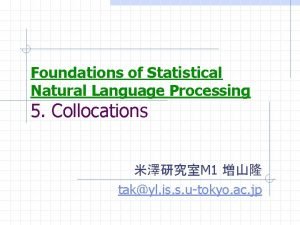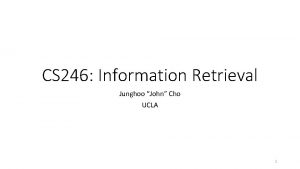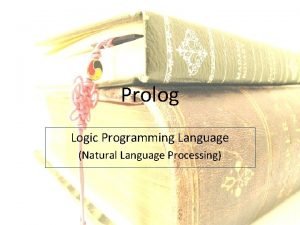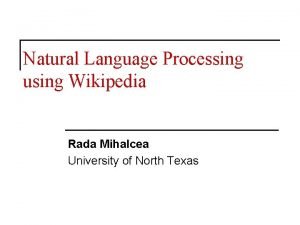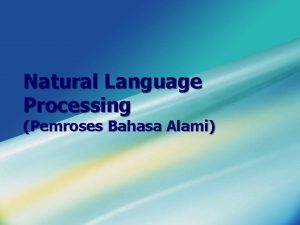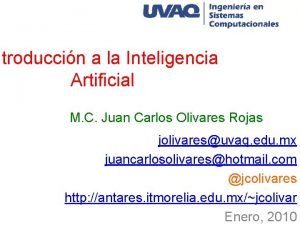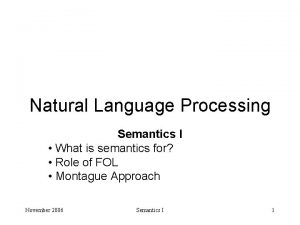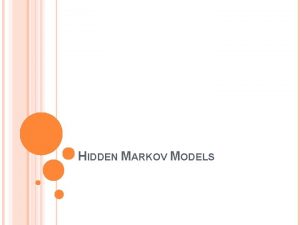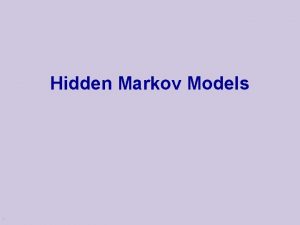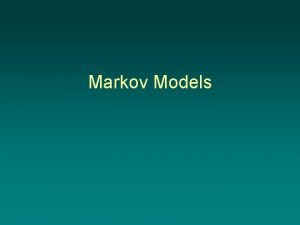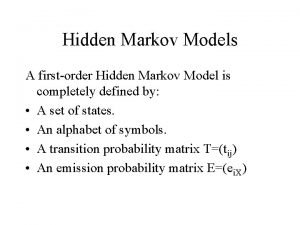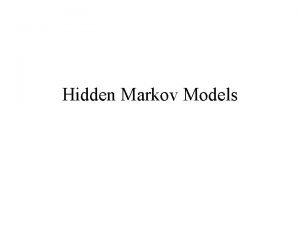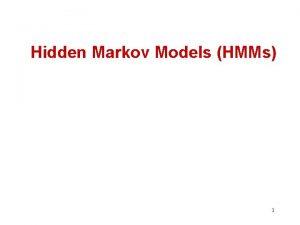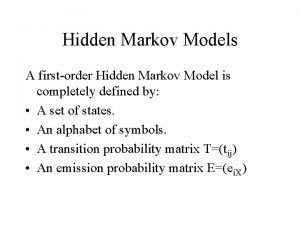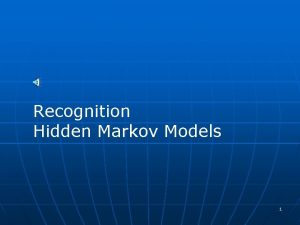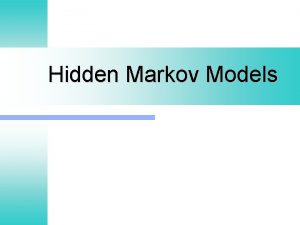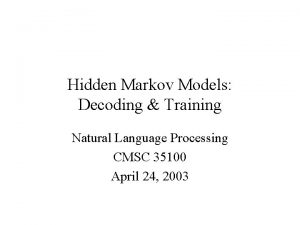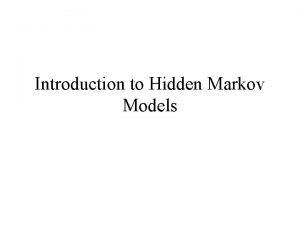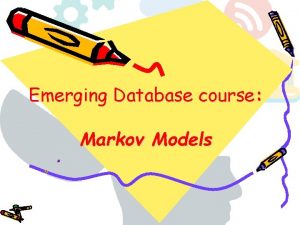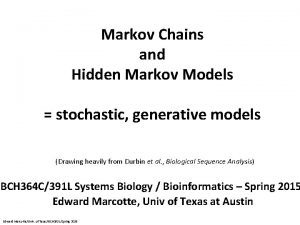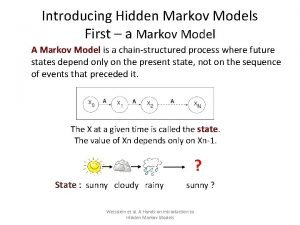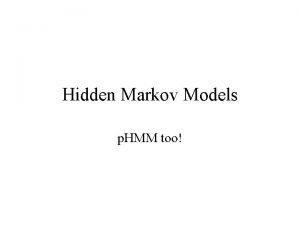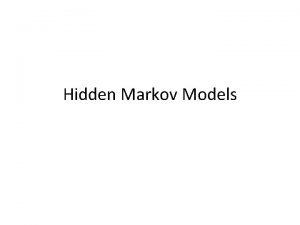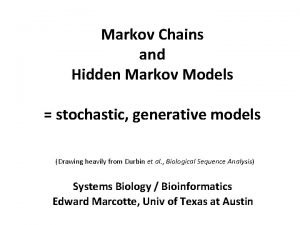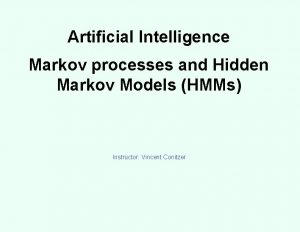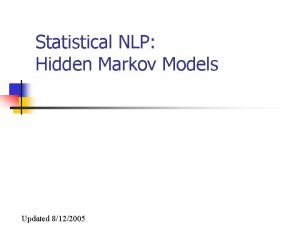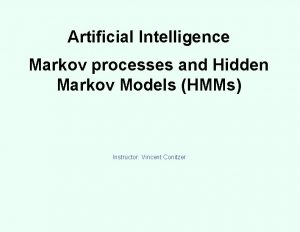Entropy Hidden Markov Models Natural Language Processing CMSC



















![Acoustic Model • 3 -state phone model for [m] – Use Hidden Markov Model Acoustic Model • 3 -state phone model for [m] – Use Hidden Markov Model](https://slidetodoc.com/presentation_image_h2/599888c2e2de7be38297796b909984b5/image-20.jpg)











- Slides: 31

Entropy & Hidden Markov Models Natural Language Processing CMSC 35100 April 22, 2003

Agenda • Evaluating N-gram models – Entropy & perplexity • Cross-entropy, English • Speech Recognition – Hidden Markov Models • Uncertain observations • Recognition: Viterbi, Stack/A* • Training the model: Baum-Welch

Evaluating n-gram models • Entropy & Perplexity – Information theoretic measures – Measures information in grammar or fit to data – Conceptually, lower bound on # bits to encode • Entropy: H(X): X is a random var, p: prob fn – E. g. 8 things: number as code => 3 bits/trans – Alt. short code if high prob; longer if lower • Can reduce • Perplexity: – Weighted average of number of choices

Entropy of a Sequence • Basic sequence • Entropy of language: infinite lengths – Assume stationary & ergodic

Cross-Entropy • Comparing models – Actual distribution unknown – Use simplified model to estimate • Closer match will have lower cross-entropy

Entropy of English • Shannon’s experiment – Subjects guess strings of letters, count guesses – Entropy of guess seq = Entropy of letter seq – 1. 3 bits; Restricted text • Build stochastic model on text & compute – Brown computed trigram model on varied corpus – Compute (pre-char) entropy of model – 1. 75 bits

Speech Recognition • Goal: – Given an acoustic signal, identify the sequence of words that produced it – Speech understanding goal: • Given an acoustic signal, identify the meaning intended by the speaker • Issues: – Ambiguity: many possible pronunciations, – Uncertainty: what signal, what word/sense produced this sound sequence

Decomposing Speech Recognition • Q 1: What speech sounds were uttered? – Human languages: 40 -50 phones • Basic sound units: b, m, k, ax, ey, …(arpabet) • Distinctions categorical to speakers – Acoustically continuous • Part of knowledge of language – Build per-language inventory – Could we learn these?

Decomposing Speech Recognition • Q 2: What words produced these sounds? – Look up sound sequences in dictionary – Problem 1: Homophones • Two words, same sounds: too, two – Problem 2: Segmentation • No “space” between words in continuous speech • “I scream”/”ice cream”, “Wreck a nice beach”/”Recognize speech” • Q 3: What meaning produced these words? – NLP (But that’s not all!)


Signal Processing • Goal: Convert impulses from microphone into a representation that – is compact – encodes features relevant for speech recognition • Compactness: Step 1 – Sampling rate: how often look at data • 8 KHz, 16 KHz, (44. 1 KHz= CD quality) – Quantization factor: how much precision • 8 -bit, 16 -bit (encoding: u-law, linear…)

(A Little More) Signal Processing • Compactness & Feature identification – Capture mid-length speech phenomena • Typically “frames” of 10 ms (80 samples) – Overlapping – Vector of features: e. g. energy at some frequency – Vector quantization: • n-feature vectors: n-dimension space – Divide into m regions (e. g. 256) – All vectors in region get same label - e. g. C 256

Speech Recognition Model • Question: Given signal, what words? • Problem: uncertainty – Capture of sound by microphone, how phones produce sounds, which words make phones, etc • Solution: Probabilistic model – P(words|signal) = – P(signal|words)P(words)/P(signal) – Idea: Maximize P(signal|words)*P(words) • P(signal|words): acoustic model; P(words): lang model

Probabilistic Reasoning over Time • Issue: Discrete models – Speech is continuously changing – How do we make observations? States? • Solution: Discretize – “Time slices”: Make time discrete – Observations, States associated with time: Ot, Qt

Modelling Processes over Time • Issue: New state depends on preceding states – Analyzing sequences • Problem 1: Possibly unbounded # prob tables – Observation+State+Time • Solution 1: Assume stationary process – Rules governing process same at all time • Problem 2: Possibly unbounded # parents – Markov assumption: Only consider finite history – Common: 1 or 2 Markov: depend on last couple

Language Model • Idea: some utterances more probable • Standard solution: “n-gram” model – Typically tri-gram: P(wi|wi-1, wi-2) • Collect training data – Smooth with bi- & uni-grams to handle sparseness – Product over words in utterance

Acoustic Model • P(signal|words) – words -> phones + phones -> vector quantiz’n • Words -> phones – Pronunciation dictionary lookup • Multiple pronunciations? – Probability distribution t ow » Dialect Variation: tomato » +Coarticulation – Product along path t 0. 2 ow 0. 8 ax 0. 5 aa m 0. 5 ey t ow

Acoustic Model • P(signal| phones): – Problem: Phones can be pronounced differently • Speaker differences, speaking rate, microphone • Phones may not even appear, different contexts – Observation sequence is uncertain • Solution: Hidden Markov Models – 1) Hidden => Observations uncertain – 2) Probability of word sequences => • State transition probabilities – 3) 1 st order Markov => use 1 prior state

Hidden Markov Models (HMMs) • An HMM is: – 1) A set of states: – 2) A set of transition probabilities: • Where aij is the probability of transition qi -> qj – 3)Observation probabilities: • The probability of observing ot in state i – 4) An initial probability dist over states: • The probability of starting in state i – 5) A set of accepting states
![Acoustic Model 3 state phone model for m Use Hidden Markov Model Acoustic Model • 3 -state phone model for [m] – Use Hidden Markov Model](https://slidetodoc.com/presentation_image_h2/599888c2e2de7be38297796b909984b5/image-20.jpg)
Acoustic Model • 3 -state phone model for [m] – Use Hidden Markov Model (HMM) 0. 3 0. 9 0. 4 Transition probabilities Onset 0. 7 Mid 0. 1 End 0. 6 Final C 3: C 1: C 2: 0. 3 0. 5 0. 2 C 5: C 3: C 4: 0. 1 0. 2 0. 7 C 6: C 4: C 6: 0. 4 0. 1 0. 5 Observation probabilities – Probability of sequence: sum of prob of paths

Viterbi Algorithm • Find BEST word sequence given signal – Best P(words|signal) – Take HMM & VQ sequence • => word seq (prob) • Dynamic programming solution – Record most probable path ending at a state i • Then most probable path from i to end • O(b. Mn)

Viterbi Code Function Viterbi(observations length T, state-graph) returns best-path Num-states<-num-of-states(state-graph) Create path prob matrix viterbi[num-states+2, T+2] Viterbi[0, 0]<- 1. 0 For each time step t from 0 to T do for each state s from 0 to num-states do for each transition s’ from s in state-graph new-score<-viterbi[s, t]*at[s, s’]*bs’(ot) if ((viterbi[s’, t+1]=0) || (viterbi[s’, t+1]<new-score)) then viterbi[s’, t+1] <- new-score back-pointer[s’, t+1]<-s Backtrace from highest prob state in final column of viterbi[] & return

Enhanced Decoding • Viterbi problems: – Best phone sequence not necessarily most probable word sequence • E. g. words with many pronunciations less probable – Dynamic programming invariant breaks on trigram • Solution 1: – Multipass decoding: • Phone decoding -> n-best lattice -> rescoring (e. g. tri)

Enhanced Decoding: A* • Search for highest probability path – Use forward algorithm to compute acoustic match – Perform fast match to find next likely words • Tree-structured lexicon matching phone sequence – Estimate path cost: • Current cost + underestimate of total – Store in priority queue – Search best first

Modeling Sound, Redux • Discrete VQ codebook values – Simple, but inadequate – Acoustics highly variable • Gaussian pdfs over continuous values – Assume normally distributed observations • Typically sum over multiple shared Gaussians – “Gaussian mixture models” – Trained with HMM model

Learning HMMs • Issue: Where do the probabilities come from? • Solution: Learn from data – Trains transition (aij) and emission (bj) probabilities • Typically assume structure – Baum-Welch aka forward-backward algorithm • Iteratively estimate counts of transitions/emitted • Get estimated probabilities by forward comput’n – Divide probability mass over contributing paths

Forward Probability

Backward Probability

Re-estimating • Estimate transitions from i->j • Estimate observations in j

Does it work? • Yes: – 99% on isolate single digits – 95% on restricted short utterances (air travel) – 80+% professional news broadcast • No: – 55% Conversational English – 35% Conversational Mandarin – ? ? Noisy cocktail parties

Speech Recognition as Modern AI • Draws on wide range of AI techniques – Knowledge representation & manipulation • Optimal search: Viterbi decoding – Machine Learning • Baum-Welch for HMMs • Nearest neighbor & k-means clustering for signal id – Probabilistic reasoning/Bayes rule • Manage uncertainty in signal, phone, word mapping • Enables real world application
 A revealing introduction to hidden markov models
A revealing introduction to hidden markov models A revealing introduction to hidden markov models
A revealing introduction to hidden markov models Hidden markov models
Hidden markov models Markov chain natural language processing
Markov chain natural language processing Hidden markov chain
Hidden markov chain Hidden markov model rock paper scissors
Hidden markov model rock paper scissors Hidden markov model tutorial
Hidden markov model tutorial Hidden markov chain
Hidden markov chain Hidden markov chain
Hidden markov chain Hidden markov map matching through noise and sparseness
Hidden markov map matching through noise and sparseness Hmm tutorial
Hmm tutorial Hidden markov model
Hidden markov model Natural language processing vietnamese
Natural language processing vietnamese Probabilistic model natural language processing
Probabilistic model natural language processing Natural language processing nlp - theory lecture
Natural language processing nlp - theory lecture Christopher manning nlp
Christopher manning nlp Language
Language Buy nlu
Buy nlu Natural language processing lecture notes
Natural language processing lecture notes Foundations of statistical natural language processing
Foundations of statistical natural language processing Natural language processing fields
Natural language processing fields Statistical nlp
Statistical nlp Natural language processing nlp - theory lecture
Natural language processing nlp - theory lecture Façade michael mateas
Façade michael mateas Collocation 例
Collocation 例 Ucla natural language processing
Ucla natural language processing Prolog natural language processing
Prolog natural language processing Rada mihalcea
Rada mihalcea Pengertian natural language processing
Pengertian natural language processing Natural language processing
Natural language processing Language synonyms
Language synonyms Logical form
Logical form
